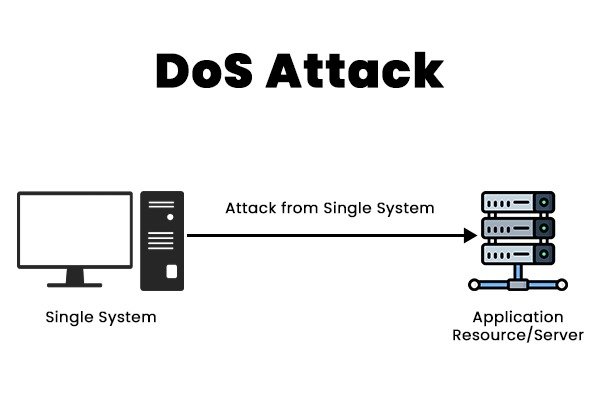Understanding Denial-of-Service (DoS) Attacks


What is a Denial-of-Sercie (DoS) attack?
A Denial-of-Service (DoS) attack is a type of cyber attack where a malicious actor seeks to make a computer, server, or network resource unavailable to its intended users by overwhelming it with traffic or requests. The goal of a DoS attack is to disrupt the normal functioning of the targeted system, rendering it incapable of processing legitimate requests from users. The result? Service disruption, downtime, and a significant impact on business operations.
In most cases, a DoS attack is launched from a single machine. In contrast, a Distributed Denial-of-Service (DDoS) attack involves multiple machines working in unison, often controlled by botnets (a network of compromised devices), to flood the target with traffic
DoS (Denial-of-Service): A cyber attack that makes a computer or network resource unavailable to its intended users by overwhelming it with excessive traffic or requests.
DDoS (Distributed Denial-of-Service): A variant of a DoS attack that originates from multiple sources, often leveraging botnets.
Botnet: A network of compromised devices, often used for large-scale DDoS attacks.
How Does a DoS Attack Work?
The core concept behind a DoS attack is simple: overwhelm a system to the point where it can no longer process legitimate user requests. Attackers exploit the limited capacity of the targeted machine, network, or application to disrupt its normal operations.
DoS attacks can be carried out through several vectors, which can generally be classified into two categories:
Buffer Overflow Attacks:
A buffer overflow occurs when an attacker sends more data to a program or system than it can handle, causing the system to consume excessive resources like CPU, memory, or storage.
This attack can cause system crashes, slowdowns, and overall instability, leading to a denial of service. In many cases, buffer overflow vulnerabilities are exploited to disrupt server operations and cause delays in handling legitimate traffic.
Flood Attacks:
These attacks involve saturating a targeted system with massive amounts of traffic. The goal is to exhaust the server’s bandwidth and processing power, rendering it incapable of handling valid requests.
These attacks can include sending a huge volume of packets or connection requests to a target, leading to resource exhaustion. For flood attacks to be effective, the attacker typically needs more bandwidth than the target system.
Types of DoS Attacks
While DoS and DDoS attacks can occur in various forms, some common types of attacks include:
- SYN Flood Attack:
- This attack exploits the TCP handshake process by sending a flood of SYN (synchronize) requests to a target server without completing the handshake. As the server waits for the handshake to be completed, its resources become consumed, eventually leading to a denial-of-service.
- Ping of Death:
- This involves sending malformed or oversized packets to a system in order to crash or freeze it. It’s a simple but highly effective attack.
- Amplification Attacks:
- In some cases, attackers can send a small request to a server that generates a larger response, overwhelming the target. These attacks can amplify the amount of traffic sent to the victim.
So what’s the impact?
The consequences of a Denial-of-Service attack can be significant:
- Service Disruption: Websites or services can become inaccessible for a period of time, leading to loss of business opportunities, customer frustration, and brand damage.
- Financial Loss: Downtime can result in direct financial loss, especially for e-commerce businesses or services that rely on consistent uptime.
- Reputation Damage: Extended outages can harm your brand’s reputation, eroding customer trust and loyalty. It is important to establish security+ training to employes
- Resource Exhaustion: DoS attacks can drain valuable resources like bandwidth, storage, and CPU time, resulting in poor performance for legitimate users.
How to protect?
To safeguard against DoS attacks, businesses should adopt a multi-layered security approach that includes:
- Network Monitoring: Implement continuous monitoring to detect unusual traffic spikes and potential threats.
- Traffic Filtering: Use firewalls and intrusion prevention systems (IPS) to filter malicious traffic and block known attack vectors.
- Content Delivery Networks (CDNs): CDNs can help distribute traffic across multiple servers, reducing the risk of a successful DoS attack by offloading requests from the origin server.
- Rate Limiting: Configure servers to limit the number of requests per IP or per user to prevent any one user or bot from overwhelming the system.
- Load Balancing: Distribute incoming traffic across multiple servers to prevent any single server from becoming overloaded.
At Sentry Intelligence Services, we specialize in providing comprehensive cybersecurity solutions tailored to protect your business from DoS attacks and other malicious threats. Our expert team offers proactive monitoring, traffic filtering, and robust defense strategies to ensure your infrastructure remains secure and resilient.
Contact Sentry Intelligence Services today to learn more about how we can safeguard your organization against DoS attacks and ensure the continued availability of your critical services.


